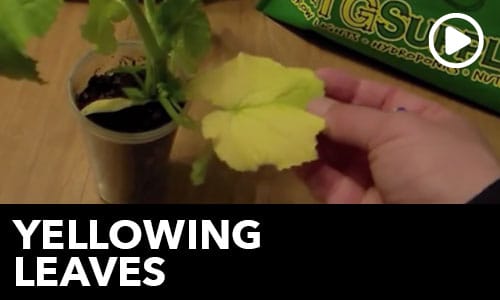Maximizing growth and yield of any plant involves optimizing growth limiting factors; with light, water, nutrients, temperature, and air being the most obvious factors to focus on. While many people correctly focus on nutrients, water and temperature it turns out that improving air in the grow room can actually have one of the biggest returns of all. This is one area where growing indoors provides a distinct advantage in controlling the atmosphere, specifically through CO2 enrichment. Read on to learn more about the basics and benefits of CO2, as well as the differences between enrichment methods. Plus, get the coupon code of the week to save on enrichment gear/supplies if you’re ready to get started with CO2!
What is Carbon Dioxide / CO2?
Let’s start with the basics – Carbon dioxide is a molecule made up of one atom of carbon and two oxygen atoms. Carbon dioxide is a naturally-occurring gas that makes up about 0.03-0.04% of our atmosphere. It’s nontoxic, colorless and odorless, and is vitally important to all life on planet Earth. The planet is constantly moving carbon around in what scientists call the carbon cycle. Plants take CO2 from the atmosphere to do photosynthesis i.e. make sugars, proteins and other molecules. You eat the sugars and proteins in plants, and as you break them down for energy you produce CO2, you’re doing it right now! Every time you exhale some of the food you ate comes out as CO2 into the atmosphere where plants will use it to make sugar etc., and the cycle continues.
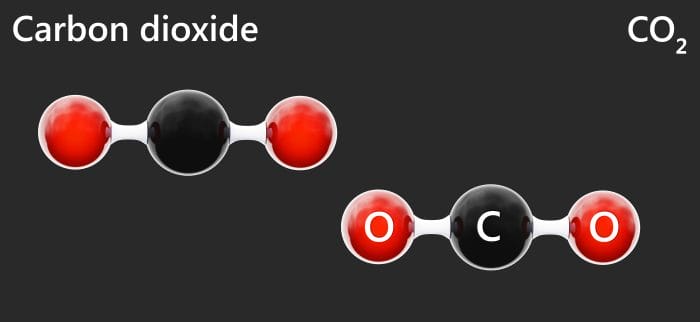
It’s a little-known fact that there used to be much higher levels of CO2 in the atmosphere in the Earth’s ancient history. Moreover, these heightened levels of CO2 and the warmer climate that occurred then allowed for gigantic plants to grow. However, if those plants were subject to modern CO2 levels, their growth would be diminished because photosynthesis (the process by which plants use CO2) would occur slower with the lower CO2 levels. Conversely, modern plants would grow much faster and larger with those prehistoric CO2 levels. Indoor growers can create elevated carbon dioxide levels indoors to produce the increased rate of photosynthesis, which is referred to as CO2 enrichment.

How Do Plants Use Carbon Dioxide
You might already know that plants take in carbon dioxide and give off oxygen, but do you know why? During photosynthesis, plants take in water and CO2 and use light to make sugars, proteins and most organic molecules they need. Dr. Myers explains more on the role of CO2 in photosynthesis:Plants split the water molecule (H2O), releasing the oxygen through the stomata and add the hydrogen to the CO2 to form a sugar, which your plant uses for energy. The sugars and the energy from breaking them down goes into making amino acids, cellulose, oils, and pretty much everything else your plant is made of.
What is the optimal amount of CO2 to use? The Earth’s ambient CO2 levels are around 400ppm right now, and most people’s gardens will be fine at that level. However, many studies have shown that most plants will grow faster and bigger if they are given more CO2 than naturally occurs in the atmosphere. The optimal level for plants in our indoor gardens is between 1200 and 1500 ppm. Anything above that will begin to show diminishing returns (so, there’s still a benefit, but it’s less and less of a benefit and it takes more and more CO2 which uses your time and money).
Factors That Affect CO2
You now know adding extra CO2 can benefit your indoor garden and it may lead to bigger plants (and bigger yields), but there are several other factors at work behind making your extra CO2 increase plant growth. First and foremost is your light source or the grow lights you’re using because photosynthesis requires light energy to work – if there is low light energy, the rate of photosynthesis will be lower. Water is the second factor that affects photosynthesis, too much or too little water in your potting soil will also reduce photosynthesis no matter how much CO2 your plants have. Water in the soil is important but also the humidity of your grow environment plays a big role as well. Low humidity can cause your plant’s stomata to close up tight in order to avoid a loss of moisture, but high humidity can cause your plants not to open their stomata since there’s no loss of moisture for the plant to make up for. So, you need to keep the water in your medium and your atmosphere at optimal levels to get the most from supplemental CO2.
Before you jump into buying equipment for CO2 enrichment you should know adding a fan to your grow area can increase the CO2 available to your plants. Your plant’s leaves are surrounded by little pockets of air, which (in nature) are replenished regularly by the wind. Those little air pockets contain the CO2 that your plant is actually taking in; CO2 intake is a passive process, meaning your plant isn’t actively doing anything. Indoors plants are absorbing the CO2 next to the leaf/stomata and since wind isn’t much of a factor, the area around the leaves can have lower levels of CO2 as plants use the CO2. A small fan circulating a light breeze in your garden will ensure that the leaves’ little air pockets are being replenished and that by itself can be a huge help to your plants in terms of CO2 intake.
Methods of Adding CO2 for Indoor Gardens
As for actually ADDING carbon dioxide to your garden, there are several ways to go about it. The right method for you will depend largely on how large your grow space is as well as how much you’re willing to invest in it up front. In any case, there are a few reliable and effective options that are guaranteed to produce a return:
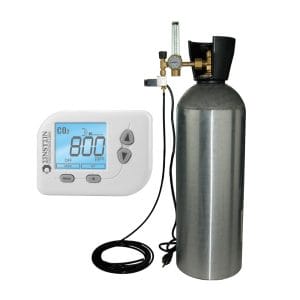
CO2 Tank and Regulator Systems – Tank and regulator systems are probably the most popular method of CO2 enrichment for those with average size indoor gardens. This system simply uses a metal canister or CO2 tank full of compressed CO2, which provide a controlled output of CO2 when fitted with a regulator. The CO2 regulator used in this application contains a solenoid (electronic) which allows it to be triggered by programmable electronic timers or controllers. That means you can set your CO2 output to occur steadily over the course of the light hours, then to shut off during the dark ones. This way, you can maximize your plant’s exposure to CO2 and minimize the waste. While a simple timer can be used to operate these systems, it is best to pair them with a monitor or CO2 controller which can automatically adjust the amount of CO2 being released into the garden to maintain a specific level of CO2 further improving the efficiency of the system. The only real drawbacks to this type of setup are that the canisters have to be regularly refilled/replaced and that they are only able to provide coverage for a modestly sized area. That’s not much of a problem if you’re growing in a regular-sized grow tent, a closet, or a small and you’re near an HTG Supply because we have CO2 tanks for sale and refill them at most shops as well. But if you’re planning something larger in scale, you’d still need too many of the canisters for it to be feasible.
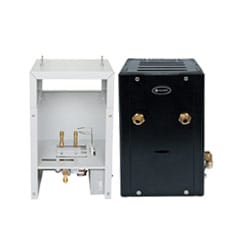
CO2 Generators – A CO2 generator uses tanks of propane or natural gas (or even gas lines, depending on the size and sophistication of the setup) in combination with a high-efficiency burner system to produce CO2. These CO2 generators are much more efficient at filling large spaces with CO2 than tank and regulator systems, but they do present their own set of challenges. Generators create CO2 as a byproduct of burning gases, which means that they can create a significant amount of heat. Heat from generators can’t be regulated via conventional methods like ventilation because doing so would also waste most of the CO2 being produced, so these setups often require completely contained cooling methods like enclosed air conditioners (which themselves tend to dry out the air a little, causing the need for a humidifier). While there are many ways to produce CO2 through combustion, it is important to note that only CO2 generators rated for indoor horticultural applications should be used in the grow room. These generators ensure that fuels are burned completely for safe use indoors. Because they can rapidly produce large amounts of CO2, generators should almost always be used with a CO2 controller to ensure levels remain optimal, which does increase the up-front cost of a system. All that aside, CO2 generators are the most efficient CO2 dispersal systems available and are completely safe when properly utilized.
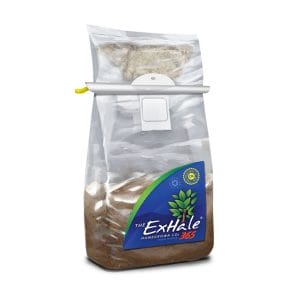
CO2 Bags – For those of us on a budget (and those of us just dipping our toes in the CO2 pool), there are products like Exhale CO2 Bags which put out a steady, controlled amount of CO2 over a period of time. Exhale bags or CO2 bags utilize fungus to produce carbon dioxide through natural means. These CO2 bags can produce significant amounts of CO2, but they are mostly designed for very small spaces, no bigger than an average tent or a closet. You would likely need more than one to see any benefit even in a fairly small room. They don’t put out a large amount of CO2 like tank/regulator or generators and their period of effectiveness is limited, but that doesn’t mean that they’re ineffective by any means. You’ll likely notice a difference in the vitality of the plants in your garden – it just won’t be a huge one. This is an excellent and cost-effective way to test whether CO2 will enhance your results (or whether you should focus on other areas first), so many new growers set up two small tents and add one of these to only one of the tents to see whether the plants in that tent grow larger or more heartily than the other. The biggest drawback to these methods is that the CO2 is totally unregulated and there’s no way to control when or how much is released.
Other Methods
Homemade CO2 – Lastly, there are several “homemade” methods of adding CO2 to your garden, some of which are a little outlandish. Things like letting dry ice sit out and sublimate in your garden, mixing yeast into sugar water or baking soda into vinegar, even brewing beer in the room! While it’s true that all of these methods technically produce CO2, none of them feasibly do so in any amount that would make a difference to your plants – the effect would be similar to adding individual grains of sugar to your tea to sweeten it. We recommend against using homebrew methods, not necessarily because they’re dangerous, but because they don’t really work on the scale needed for plant growth and it’s better to save the money and time you would spend on them (or to put it toward a method that works instead).
Monitor & Control CO2
So, now that we know how (and how not) to add CO2 to our gardens, let’s talk about some of the accessories that you’ll need. If you’re using a tank and regulator or generator system, the first and most important thing you’ll want is a CO2 monitor or CO2 controller. That’s the only way you’ll actually know how MUCH carbon dioxide is in your grow space. Remember, your goal isn’t to pump loads of CO2 in and hope for the best, your goal is to maintain an ideal level. Most CO2 controllers provide the ability to set a specific ppm level or ppm range, which is useful not only for optimizing levels, but also adjusting to growth phases. Many controllers also have the ability to coordinate with grow room ventilation systems to ensure CO2 is not being utilized while ventilation is on, which further improves efficiency. Although CO2 can be controlled with a timed release, this technique is only really applicable to tank and regulator systems, and not recommended for generators.
Administering CO2
Aside from choosing an enrichment and monitoring/regulating method, there are other measures involved in properly administering CO2. First, ensuring proper air circulation within the space is crucial to getting the most out of your CO2 enrichment system. An oscillating fan will ensure all of your plants are being evenly and consistently surrounded by enriched air (and also that the plants are growing up sturdy and strong; see our article on grow room air circulation to learn more about airflow in your garden). The limits of temperature and humidity can also be stretched a bit when CO2 is being administered properly. Warmer temperatures, 3-5°F higher than normal (75-80°F), will help to speed up photosynthesis, while humidity levels between 40-60% will help to ensure stomata are open for maximum CO2 intake.
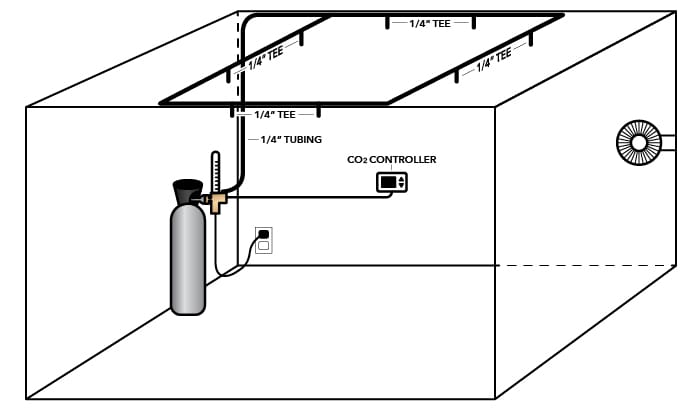
CO2 Tank and Regulator Setup Diagram
When using tanks, you should know that CO2 is heavier than air. That means you should release the CO2 above your plants. If you release it at the level of your plants the CO2 will sink to the floor and not be available. Also, you want your grow area to be as sealed as possible. When the CO2 is released you want the plants to use it, not for it to leave through an open door or vent. Releasing CO2 above your plants and into a sealed room will mean you use less CO2 but get the most from it.
Finally, and perhaps most importantly, the rest of your limiting factors should also be closely monitored and maintained. Remember, you’re essentially supercharging your plants’ air supply, but this is basically only half of the photosynthesis equation. Supplemental CO2 won’t do you half as much good if your light levels are lacking, so be sure your lights are performing as they should, whether you’re using LED grow lights, HID’s, or anything else. Further, your plants will have the capacity to use significantly higher amounts of water and nutrients so these factors need to be closely monitored once CO2 enrichment is in use. This is easier done in hydroponics than soil by simply eyeing your reservoir and using a ppm meter to test nutrient uptake but a general rule to ensure proper nutrition, in either case, would be to use your manufacturer’s ‘aggressive feeding’ recommendations.
When it comes to CO2 enrichment, the question doesn’t lie in whether it works or not, but how to make it work to its full potential. When properly administered, growers using CO2 enrichment can expect to see a 30-50% increase in yield over growth in ambient carbon dioxide levels. As long as they’re getting the light, nutrients, and care they need as well, adding CO2 to your garden can only spell out success!____________________Questions, tips, or tricks to share? Join the conversation, and share your CO2 enrichment experiences! Throw a picture on Instagram and tag us in it (@HTGSupply) – we’d love to see your results! And don’t forget to check out this week’s coupon code and sale information below! From all of us here, good luck, stay safe, and Happy Growing!

THIS WEEK’S COUPON CODE: CO2GROW
Enter this week’s promo code at checkout for a 10% discount on any CO2 enrichment supplies*, as well as the popular foliar nutrients featured below. Visit your local HTG Supply and simply mention this article to get the deal in-store as well! Thanks again for tuning into Talking Shop with HTG Supply! Offer valid through HTGSupply.com and in-store 01/26/18-02/02/18. Cannot be combined with other offers. Follow us on social media for all the Sales, Events and Customer Appreciation Days. In addition, learn more about indoor growing and get all kinds of tips, tricks and techniques!
*Equipment only – CO2 tank fills/refills excluded
By: HTG Supply 01/25/2018

